
Roll out the Barrel!
(written by Mary Dunn, former Library staff)
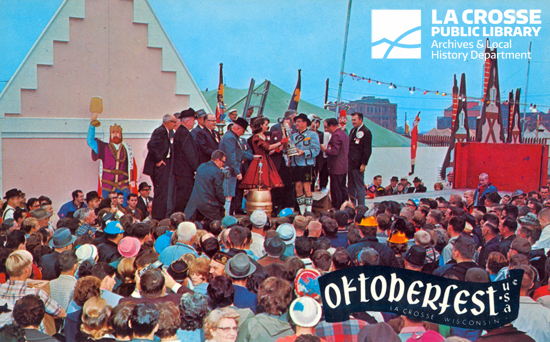
The tapping of the Golden Keg marks the official start to Oktoberfest. This scene from 1964 features Fest Master Roy Kumm of the G. Heileman Brewing Company doing the honors.
It's almost time for this year's Oktoberfest to begin. But how did La Crosse's Oktoberfest actually start?
Some say it began on the golf course in 1960. Businessmen Roy Kumm from G. Heileman Brewing Company; Ray Ping from Erickson Bakery; Don Rice from the Exchange State Bank; and John Coleman from the La Crosse Vocational College, were having their weekly golf game and discussing ways to promote La Crosse. After getting the Chamber and other businesses involved, all parties agreed that fall would be a perfect time of year for a festival with our nice weather. The dates of the first fest were October 13-15, 1961.
The 1961 fest was originally advertised as a farm fair. There was something for all members of the family. The Oktoberfest medallion hunt was officially started. Some of the events from that fest included a greased pig catching contest, houseboat rides, a soccer match between the Milwaukee Bavarians and the St. Paul Soccer Club and a German band contest for all ages. There was also a separate award for the best dressed accordion player. For $1.75 you could take a railroad excursion to Ferryville. The train left from the train station on 2nd and Pearl. Two and a half tons of bratwurst were consumed, and around 50,000 people attended the Maple Leaf Parade that first year.
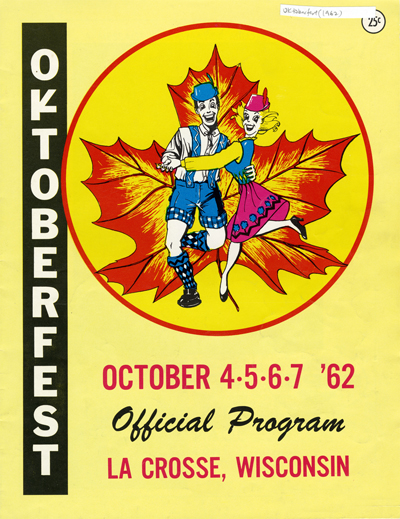
The official program from the 1962 Oktoberfest is shown here.
1962 brought the first Fest Master - Don Rice. The first four fest masters were chosen by the Board of Directors president, but later fest masters were chosen by the previous fest masters. Other fun events were a rodeo, Frankie Yankovic, and the Don McNeill's Breakfast Club was broadcasted live. People came from all over the United States to attend. The Maple Leaf parade was shown live on WKBT using just one camera. This was the first live parade shown on WKBT. Around 70,000 people attended the parade that year.
The growing fest added more events in 1963. Featured entertainment was Guy Lombardo and his Royal Canadian orchestra that year. Also added was a bowling tournament as well as scenic bus and boat tours. The fest was now being promoted in big cities such as Minneapolis and Chicago. Railroad cars were being chartered from the Twin Cities to bring people to the fest. The Burlington train depot brought visitors right to the downtown in those days. Best units from the Maple Leaf parade were chosen to be in another parade following the Maple Leaf parade. Because it started to get dark, participants carried flashlights. That idea eventually became the Torchlight Parade. There were 237 units in the three-hour Maple Leaf parade which was watched by what had grown to 150,000 people.
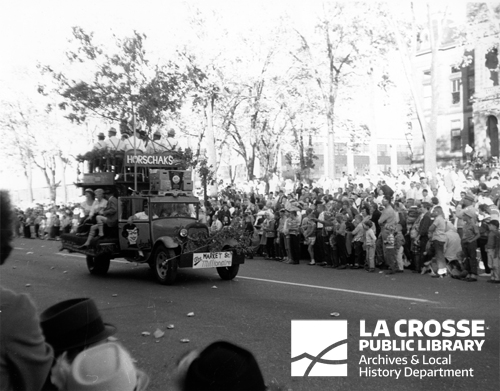
A scene from the 1964 Maple Leaf parade show Horschak's Tavern entry chugging down Third Street between Vine and State streets.
Louis Armstrong returned to La Crosse to open the 1964 fest. Armstrong first visited La Crosse in 1916 on excursion boats that featured a Dixieland band. In the afternoon before Armstrong's show, was the parade of the white and gold beer wagon from the Heileman Brewery to the fest grounds. The tapping of the Golden Keg was done by Fest Master Roy Kumm, marking the official opening of fest. Around 210,000 attended the Maple Leaf parade. 1,270 half barrels of beer were drunk while 75,000 brats were devoured. There were also 39,000 buttons sold and 600 helium balloons were filled with gift cards promoting the fest and local businesses, but only five gift cards were redeemed.
In 1965 La Crosse was called Munich on the River. The Maple Leaf parade was getting national attention and more groups wanted to participate in it. 225,000 attended the parade in 1965. People were complaining that the Maple Leaf parade was getting too long and it was decided that it would become a Southside parade. That really irritated Northsiders and northside businesses refused to sell buttons unless the northside was included. The revolt was led by Vern Bloss who would eventually become the first Torchlight parade marshal. It was decided a new parade would be formed to have overflow units from the Maple Leaf parade and it would be a Northside parade. Real torches were used during the 1960s to light the parade route.
Times were changing all over in 1966. The Vietnam War was on, and crowd unrest and violence were evident at almost all major festivals in the United States. Thousands of students came from all over to attend Oktoberfest. Some slept in cars, parking ramps, telephone booths or just wandered the streets. 181 were jailed compared to 96 in 1965. Police described the scene downtown on the weekend as a "near riot." When the mess was cleaned up, 90 percent of the empties were from out of town breweries. The La Crosse Common Council passed a public consumption ordinance after the fest. Count Basie was the featured performer and a flower show was held as well as a Family Circus Friday at the Northside grounds. Residents were calling to end the fest because of the influx of college students and excessive drinking. Instituting a minimum age of 21 to consume beer was proposed for the fest for the following year.
1967 was not a very good year for the Fest. The Fest was held but there was no beer tent. Because of problems in 1966, the City refused to grant a beer license. With no beer sales and horrible weather, there was a large financial loss. The Golden Keg tapping was replaced with a golden cheese cutting served with milk. Governor Knowles served milk and cheese to kick off the Fest. Heileman Brewing withdrew all visible financial and name support for one year. Bad publicity was causing the City more harm than good. On a positive note, the Fest Master's Ball was held for the first time. Businessman Jay Hoeschler said "an Oktoberfest without beer is like a wedding without a bride."
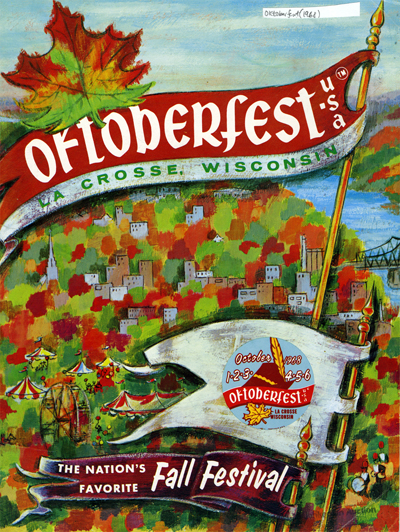
Program from the 1968 Oktoberfest.
The Fest almost died in 1968 because of financial trouble. Requests were sent to local businesses and professionals to ask for their support by purchasing memberships, and enough money was raised to pay off all the debt. The Fest was now being rebranded to include family in all advertisements. Mrs. Oktoberfest was born in 1968. 80 women entered the contest and the field was narrowed to 18. Contestants were judged on homemaking, participating in church, school and civic affairs, poise and personality, cooking, special talents and hobbies. The first Mrs. Oktoberfest was Mrs. Joyce Lindseth. She made peppermint brownies for her cooking entry and sewed a fest dress for the handicraft competition.
1969 brought the Flower Show to the Mary E. Sawyer Auditorium. There were different artistic divisions with some specifying certain materials. Some of the categories were the horticulture division, toast to the fest master (arrangements had to be in a beer stein), and Hixon House tour (arrangements had to be in an antique container). Grenadiers were started in 1969. Stan Kenton and his Orchestra was the featured performer.
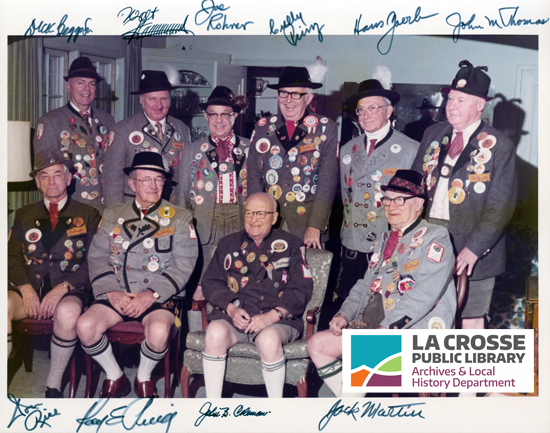
Early Fest Masters included those seen here. Front row, seated left to right: Don Rice, Ray Ping, John Coleman and Jack Martin. Back row, standing left to right: Richard "Dick" Beggs, Sr., Walt Hammond, John Rohner, Carlton "Cully" Prinz, Hans Zoerb and John Thomas.
Over the years many other events have been associated with Oktoberfest. Square dancing, baton twirling and threshing demonstrations in the early years to photography and needlework shows and a medallion hunt still going on. There's always something to do. So, get your lederhosen on and get ready for La Crosse's next Oktoberfest.
To watch Mary Dunn's 2020 presentation on this topic, watch her Monday Morning at Main program below.
